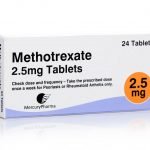What To Expect After Taking Methotrexate For Ectopic Pregnancy

What is methotrexate?
Methotrexate is a medication used to treat severe psoriasis (a skin disease in which red, scaly patches form on some areas of the body) that cannot be controlled by other treatments. Methotrexate is also used along with rest, physical therapy, and sometimes other medications to treat severe active rheumatoid arthritis (RA; a condition in which the body attacks its own joints, causing pain, swelling, and loss of function) that cannot be controlled by certain other medications. Methotrexate is also used to treat certain types of cancer including cancers that begin in the tissues that form around a fertilized egg in the uterus, breast cancer, lung cancer, certain cancers of the head and neck, certain types of lymphoma, and leukemia (cancer that begins in the white blood cells). Methotrexate is sometimes given when other medicines have not been effective.
How methotrexate works
Methotrexate is in a class of medications called antimetabolites. Methotrexate treats cancer by slowing the growth of cancer cells this interferes with the growth of certain cells of the body, especially cells that reproduce quickly, such as cancer cells, bone marrow cells, and skin cells. Methotrexate treats psoriasis by slowing the growth of skin cells to stop scales from forming. Methotrexate may treat rheumatoid arthritis by decreasing the activity of the immune system.
Methotrexate, a folic acid antagonist, is contraindicated in pregnancy (category X), because it is an abortifacient and has teratogenic effects, such as causing the development of craniofacial abnormalities, limb defects, and such CNS defects as anencephaly, hydrocephaly, and meningomyelopathy, especially with first-trimester exposure. Because its active metabolites have a long half-life, methotrexate must be discontinued at least 3 months before conception.
Why is methotrexate given in pregnancy?
Doctors sometimes use methotrexate injections in the management of ectopic pregnancy because of the drug’s ability to interrupt the growth and division of a fertilized egg. Specifically, methotrexate interrupts the supply of a hormone called human chorionic gonadotropin (hCG) to the fertilized egg. Without hCG, the egg cannot grow.
According to the American Academy of Family Physicians (AAFP), ectopic pregnancies occur in about 1 out of every 50 pregnancies (20 out of 1,000).
An ectopic pregnancy occurs when a fertilized ovum implants on any tissue other than the endometrial lining of the uterus. An ectopic pregnancy most often occurs in a fallopian tube, which carries eggs from the ovaries to the uterus. This type of ectopic pregnancy is called a tubal pregnancy. Sometimes, an ectopic pregnancy occurs in other areas of the body, such as the ovary, abdominal cavity, or the lower part of the uterus (cervix), which connects to the vagina.
An ectopic pregnancy can’t proceed normally. The fertilized egg can’t survive, and the growing tissue may cause life-threatening bleeding if left untreated.
How long is methotrexate in your system after ectopic?
Methotrexate has a half-life of 8 to 15 hours, but its presence in the liver has been reported to last up to 116 days after exposure to the drug. As a result, methotrexate can stay in your system for up to 4 months.
What will happen after you get methotrexate?
After you get methotrexate, you may have:
• mild to moderate cramps or pain in the abdomen
• vaginal bleeding (like a period)
Can an ectopic pregnancy rupture after methotrexate?
During methotrexate treatment of ectopic pregnancy, the risk of rupture ranges from 7% to 14%. It should be noted that almost all ectopic pregnancies—more than 90%—occur in a fallopian tube. As the pregnancy grows, it can cause the tube to burst (rupture). A rupture can cause major internal bleeding. Any of the following warrant an immediate visit to the emergency room:
- Sudden, severe abdominal or pelvic pain
- Dizziness or fainting
- Pain in the lower back
- Pain in the shoulders (due to leakage of blood into the abdomen affecting the diaphragm)
How much bleeding is normal after methotrexate for ectopic pregnancy?
Generally, you should expect to have vaginal bleeding which is light or like a period. This lasts a few days but you may have a brown discharge for two to three weeks. About two to seven days after the injection you will probably have some pain in your lower abdomen. It should not be severe and lasts four to 12 hours.
How do I know if methotrexate is working for ectopic pregnancy?
Only a medical doctor can objectively determine if methotrexate is working properly for you and this usually requires a blood test at the clinic or hospital 1 week after receiving methotrexate. You will need to repeat this test once a week until we can see that there is no more pregnancy hormone left in your body. The current measure of treatment efficacy of single-dose methotrexate for ectopic pregnancy is a fall in serum hCG of ≥15% between days 4–7 of treatment, which has a positive predictive value of 93% for treatment success.
What happens if hCG rises after methotrexate?
Studies have shown that serum hCG levels rise immediately after methotrexate administration for ectopic pregnancy in 50%-70% of patients. A rise in serum hCG after methotrexate treatment for ectopic pregnancy is usually associated with a lower success rate of medical treatment in patient diagnosed with ectopic pregnancy, when this happens other treatment alternatives will be explored by your doctor.
How long does it take for hCG to drop after methotrexate treatment?
Studies have shown that it takes between 0 to 4 days for a single-dose methotrexate treatment to cause a fall in serum hCG after using the medication to treat ectopic pregnancy.
What are the likely side effects you may experience?
Side effects of methotrexate may include:
• nausea and/or vomiting (for 24 hours)
• decreased appetite
• sores in the mouth
• headache
• feeling tired
• redness, swelling, or pain at the injection site
• having trouble sleeping
• diarrhea
• hair loss (rare)
How can you care for yourself at home after methotrexate treatment?
If you have nausea, sip clear fluids like ginger ale or soup broth. Try to drink often and eat small amounts of dry, starchy food (like soda crackers) every 15 minutes.
To help prevent mouth sores:
- gently brush your teeth at least 2 times a day with a soft toothbrush
- rinse your mouth well 4 times a day with club soda or water
- don’t eat hot or spicy foods
If you need to take pain medicine (e.g., headache, cramping), you can take acetaminophen (e.g., Tylenol®) or ibuprofen (e.g., Advil®). For 2 days after getting methotrexate, it’s best to take acetaminophen. If the acetaminophen doesn’t help, you can take ibuprofen unless your doctor tells you not to or if you have kidney problems. If you have any questions about medicine, talk to your doctor or pharmacist.
To help relax the muscles that cause cramping, you can use a hot water bottle or a heating pad. Make sure you put a cloth between your skin and the heat, so you don’t get a burn. Taking hot baths can also help.





